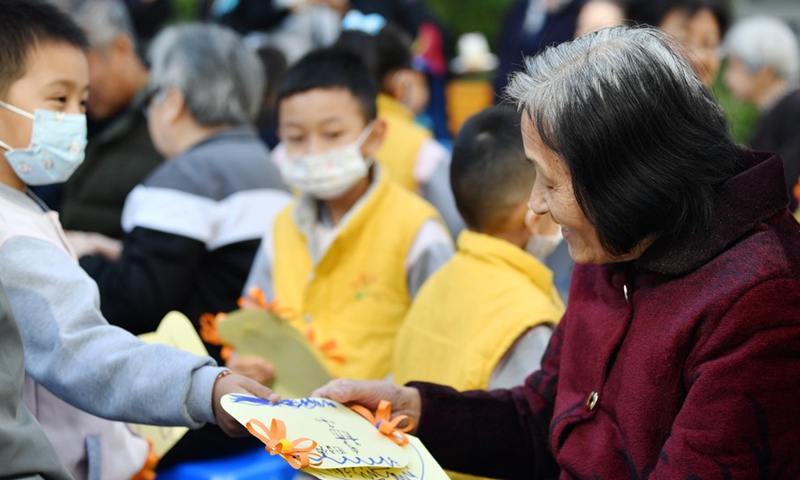
population aging Photo:Xinhua
A year after the country made a comprehensive plan for demographic structure, China's National Health Commission (NHC) released a report on Monday pointing out that women of child-bearing age have a low desire to have children, and the total population will see negative growth during the 14th Five-Year plan (2021-25) period, adding that the population's development is facing profound change, where an aging society with fewer children will become the new normal.
Experts believe that it is the first time that the Chinese government made such a public announcement, which shows its determination to tackle the population problem, and bringing fertility rates up to the international average must be achieved, and the sooner it starts, the better.
The NHC published an article entitled "Writing a new chapter in population work in the new era" on Qiushi Journal, a flagship magazine of the Communist Party of China Central Committee on Monday, in which it pointed out that factors such as heavy financial burdens, child care and women's worries about career development have become major obstacles to childbearing.
The growth rate of the total population will slow down significantly, and in the 14th Five-Year Plan period, it will enter a negative growth stage, the report said. In recent years, the total fertility rate has dropped below 1.3. The low fertility rate has become the most important risk affecting the balanced development of China's population.
In addition, with the deepening of the degree of aging, it is expected that the country will enter the stage of severe population aging around 2035, when those 60 years old and above will account for over 30 percent of the total population. According to the report, in 2020, the average family size decreased to 2.62 persons, 0.48 fewer than in 2010, and the functions of elder care and childcare were weakened.
The contradiction between the population and development remains acute in some areas with fragile ecosystems and scarce resources.
Chinese demographers have predicted that negative population growth will be the dominant trend in the coming years for a long time, and improving the overall quality of the population and changing economic development plans are vital to address the problem.
"In the past, we focused on population control, but now we should focus on raising the appropriate level of fertility, improving the quality of the population and the population structure, optimizing the population distribution, and promoting long-term and balanced population development," the NHC said in the article.
China used to rely on its demographic dividend to drive economic development, Lu Jiehua, a professor of sociology at Peking University, told the Global Times in a previous interview.
"In this case, China should explore advantages in areas beyond the demographic dividend to fully improve the overall quality of the population and create new conditions for economic development," said Lu.
The NHC said that it is time to review and abolish relevant restrictive measures, make the fertility policy more inclusive, improve comprehensive services for child-rearing, and introduce active support measures to effectively reduce the burden on the people and enhance the ability of families to develop.
The NHC stressed that China should establish and improve support for childbearing as soon as possible and policies on housing, education, healthcare, employment, taxation and social security should be appropriately tilted toward families having children to reduce the burden of childbearing, create a child-friendly social atmosphere, and stimulate families' willingness to have children.
To reduce the cost of childbirth, parenting and education, many cities and regions have rolled out measures. For example, Hangzhou in East China's Zhejiang Province issued a notice on the implementation of the preferential policy of the housing provident fund for three-child families on Monday.
According to the notice, families with three children in Hangzhou who buy their first ordinary owner-occupied home and apply for housing provident fund loans for the first time can borrow 20 percent more than the maximum loan limit of the family in the current period.
Since the beginning of this year, cities including Changsha, Ningbo, Yangzhou, Nanchang, Dongguan and Nanjing have introduced home purchase support policies for families with more than one child.
Nanchang, East China's Jiangxi Province announced on Saturday that from that day to December 31, families with two or three children under 18 years old in the newly built district will get a subsidy of 300 yuan ($45) per square meter or 500 yuan per square meter, respectively, according to their household registrations and birth certificates. Medical staff will be subsidized by 500 yuan per square meter as well to encourage births.
There may be some fluctuations in the next few years, but the negative growth rate will increase faster and faster, Huang Wenzheng, a demography expert and senior researcher at the Center for China and Globalization told the Global Times on Monday. "The official announcement of such a trend shows the country's determination to change the situation."
"Negative population growth will inevitably lead to the shrinking of family demand, and industries such as milk powder production, toys and automobiles will be affected. Population will also rapidly be concentrated in big cities, and the population gap between urban and rural areas will become more and more unbalanced," Huang noted. "As a result, bringing fertility rates up to the international average must be achieved, and the sooner it starts, the better."




